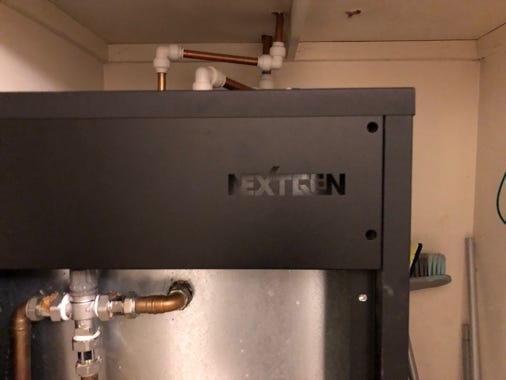
Mike the Boilerman -
Gas Safe Registered boiler and central heating repair technician in west Berkshire

Mike the Boilerman -
Gas Safe Registered boiler and central heating repair technician in west Berkshire
The NextGen Thermacoil is a bit of a strange beast with a complex history. A now-defunct company from Milton Keynes called MK Group used to market and sell it rather enthusiastically, mainly as a replacement for the Gledhill Pulsacoil 2000. The NextGen Thermacoil was originally associated with a firm named “Fabdek” or “Fabdec” who I think initially manufactured it, before handing over sales and marketing over to MK Group. MK Group used to specialise in repairing Gledhill Pulsacoils and they offered a new NextGen to Pulsacoil owners as an alternative to repairing an older Pulsacoil. Consequently, many NextGen owners previously owned a Pulsacoil .
The NextGen Thermacoil is styled to look very ‘space age’, in a matt black casing with its name in shiny black lettering. Inside the stylish casing is a basic thermal store topologically similar to the original Gledhill Pulsacoil.
How it works:
The NextGen is simply constructed, being a tankful of water heated by electric immersion heaters. This stored hot water inside is not the water that comes from the taps though, it is water that stays in the appliance for the sole purpose of storing the heat energy from the immersion heaters. The water in the thermal store never changes, and is the same water today as when the appliance was first filled by the installer. (Or last refilled by a maintenance technician.)
Hot water for the taps is generated in a coil of pipe (the ‘heat exchanger’) suspended inside the main tankful of hot water. Basically, cold mains water is connected to one end of this pipe, and the other end connects to the hot taps. When a hot tap is turned on, cold mains water passes through this pipe and it picks up heat from the stored hot water surrounding the pipe, the heat energy passing directly through the wall of the pipe. This heats the cold water as it travels to the hot tap.
This process can be very efficient leading to dangerously hot water at the hot taps, so a thermostatic blender valve controls the maximum temperature by adding cold to the very hot water if necessary.
Failure modes:
Failures fall into two categories. Failure of the unit to heat up in the first place, and failure to deliver hot water even when fully hot.
1) Failure to heat up.
There are two electric immersion heaters. One is connected to your night time off peak low cost electricity supply for low cost overnight heating. This heater is usually turned on and off by the electricity supplier automatically, but occasionally I see a time switch on the wall by the NextGen, and these time switches often fail. Otherwise, the thermostat under the connection cover of the immersion heater will probably have failed. The usual failure is tripping if the integrated overheat protection thermostat, and simply re-setting it can restore normal operation. My youtube channel has a video showing how to do this on a Pulsacoil, and the process is identical on a NextGen.
Occasionally the heater element itself can fail but this is uncommon. Check for this by measuring the resistance of the heater element with a multimeter. It should be 18 to 20 Ohms. If the resistance is hundreds of Ohms, or open circuit, a new heater element will be needed.
There is a second heater element connected to the daytime supply via a switch on the wall. This is for use when you run out of hot water and need more the same day, without waiting for the next overnight heat-up from the off peak heater element. This daytime heater element costs a lot to run so should be left OFF normally, but can suffer the same thermostat failure and tripping as the off peak heater.
2) Failure to supply hot water when the store is known to be hot:
Check the store is hot by feeling the temperature of the two pipes emerging from the top of the unit. These should be hot to the touch when the store itself is hot. If they are just warm or cool then the store is not hot, and the fault lies with the heaters not heating.
Anyway let’s assume these two pipes are hot, and the hot tap water is cold or only warm. There are two probable causes. In hard water areas a layer of water scale slowly accumulates on the inside surface of the the internal coil of pipe (the heat exhanger). This layer grows thicker over time and insulates the cool water inside the pipe from the stored hot water on the outside of the pipe, preventing the passing of heat energy through the wall of the pipe to heat the water inside the pipe. The only solution to this problem is chemical descaling of the internal pipe. Chemical descaling is technically simple but time consuming, noisy and messy, making this a significant drawback of any thermal store with this ‘internal pipe’ type of heat exchanger.
The other common cause of cool or only warm water from the hot taps when the thermal store i fully hot, is a failed or blocked thermostatic blender valve. When this happens, the blender valve blends too much cold water into the very hot water coming from the internal coil, cooling it too much. In extreme cases the blender valve fails to draw any hot water from the coil and delivers 100% cold to the hot taps. A new blender valve will fix this problem.
One further difficulty with the NextGen is pretty basic, and that is getting the front panel off to gain access to the inside. The front panel is secured with ‘security’ Torx head screws, specifically designed to prevent people gaining access. A special type of Torx wrench is needed to fit these screws in order to remove the front. Unnecessarily perverse of the designers in my opinion.
Things you can check if your NextGen stops working:
1) Check if the NextGen is actually hot. Feel the two pipes emerging from the top of the main appliance. If neither is hot the night-time heater probably isn’t working, in which case try turning ON the ‘boost’ heater. All NextGen thermal stores are prone to the night time off-peak heater failing so they have a second ‘back up’ or ‘boost’ heater to use. This is operated by an electrical switch on the wall which is usually kept turned OFF. Turn it ON and wait an hour. The hot water may well start working again. This BOOST heater is expensive to run though so you’ll still need to get the off-peak heater fixed.
2) Is the header tank sitting on top of the NextGen correctly filled with water? If not, fill it to the water level line usually marked on the side. This could take as much as several buckets of water.
3) The NextGen itself is hot but still not producing hot water. This is not easily fixed by the user as chemical descaling or a new blender valve is usually necessary. I’m afraid you’ll need to call someone like myself out.
I can give you advice and/or visit if you contact me on 07866 766364.
Hope all that helps,
Mike
NextGen Thermacoil repaired in Reading, 2019

NextGen thermostatic blender valve
The type of immersion heater on a NextGen with cover removed, showing the thermostat. This photo is actually from a Pulsacoil, which uses the same type of heater as the NextGen
If you like what I write, please Buy me a coffee. Thank you kindly!

Copyright Michael Bryant 2025
Site first published 16th January 2004
Site last updated 13th November 2025
Gas Safe Register 197499, CIPHE registration number 009909L

This website makes use of cookies. Please see my privacy policy for details.